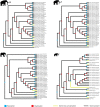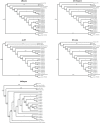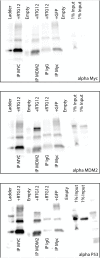TP53 copy number expansion is associated with the evolution of increased body size and an enhanced DNA damage response in elephants
- PMID: 27642012
- PMCID: PMC5061548
- DOI: 10.7554/eLife.11994
TP53 copy number expansion is associated with the evolution of increased body size and an enhanced DNA damage response in elephants
Erratum in
-
Correction: TP53 copy number expansion is associated with the evolution of increased body size and an enhanced DNA damage response in elephants.Elife. 2016 Dec 20;5:e24307. doi: 10.7554/eLife.24307. Elife. 2016. PMID: 27997337 Free PMC article. No abstract available.
Abstract
A major constraint on the evolution of large body sizes in animals is an increased risk of developing cancer. There is no correlation, however, between body size and cancer risk. This lack of correlation is often referred to as 'Peto's Paradox'. Here, we show that the elephant genome encodes 20 copies of the tumor suppressor gene TP53 and that the increase in TP53 copy number occurred coincident with the evolution of large body sizes, the evolution of extreme sensitivity to genotoxic stress, and a hyperactive TP53 signaling pathway in the elephant (Proboscidean) lineage. Furthermore, we show that several of the TP53 retrogenes (TP53RTGs) are transcribed and likely translated. While TP53RTGs do not appear to directly function as transcription factors, they do contribute to the enhanced sensitivity of elephant cells to DNA damage and the induction of apoptosis by regulating activity of the TP53 signaling pathway. These results suggest that an increase in the copy number of TP53 may have played a direct role in the evolution of very large body sizes and the resolution of Peto's paradox in Proboscideans.
Keywords: African elephant; Asian elephant; aardvark; armadillo; cell biology; evolutionary biology; genomics; hyrax.
Conflict of interest statement
The authors declare that no competing interests exist.
Figures















Comment in
-
How elephants beat cancer.Elife. 2016 Oct 31;5:e21864. doi: 10.7554/eLife.21864. Elife. 2016. PMID: 27797705 Free PMC article.
Similar articles
-
A Zombie LIF Gene in Elephants Is Upregulated by TP53 to Induce Apoptosis in Response to DNA Damage.Cell Rep. 2018 Aug 14;24(7):1765-1776. doi: 10.1016/j.celrep.2018.07.042. Cell Rep. 2018. PMID: 30110634
-
Potential Mechanisms for Cancer Resistance in Elephants and Comparative Cellular Response to DNA Damage in Humans.JAMA. 2015 Nov 3;314(17):1850-60. doi: 10.1001/jama.2015.13134. JAMA. 2015. PMID: 26447779 Free PMC article.
-
How elephants beat cancer.Elife. 2016 Oct 31;5:e21864. doi: 10.7554/eLife.21864. Elife. 2016. PMID: 27797705 Free PMC article.
-
Peto's paradox and elephant TP53 retrogenes: cancer or reproduction?Reproduction. 2025 Jul 22;170(2):e250254. doi: 10.1530/REP-25-0254. Print 2025 Aug 1. Reproduction. 2025. PMID: 40658774 Review.
-
The Role of TP53 in Adaptation and Evolution.Cells. 2023 Feb 3;12(3):512. doi: 10.3390/cells12030512. Cells. 2023. PMID: 36766853 Free PMC article. Review.
Cited by
-
Elephant Genomes Reveal Accelerated Evolution in Mechanisms Underlying Disease Defenses.Mol Biol Evol. 2021 Aug 23;38(9):3606-3620. doi: 10.1093/molbev/msab127. Mol Biol Evol. 2021. PMID: 33944920 Free PMC article.
-
Parallel evolution of reduced cancer risk and tumor suppressor duplications in Xenarthra.Elife. 2022 Dec 8;11:e82558. doi: 10.7554/eLife.82558. Elife. 2022. PMID: 36480266 Free PMC article.
-
The three dimensions of somatic evolution: Integrating the role of genetic damage, life-history traits, and aging in carcinogenesis.Evol Appl. 2020 Mar 20;13(7):1569-1580. doi: 10.1111/eva.12947. eCollection 2020 Aug. Evol Appl. 2020. PMID: 32821273 Free PMC article.
-
Gain-of-Function Mutant p53: All the Roads Lead to Tumorigenesis.Int J Mol Sci. 2019 Dec 8;20(24):6197. doi: 10.3390/ijms20246197. Int J Mol Sci. 2019. PMID: 31817996 Free PMC article. Review.
-
Cross-species identification of cancer resistance-associated genes that may mediate human cancer risk.Sci Adv. 2022 Aug 5;8(31):eabj7176. doi: 10.1126/sciadv.abj7176. Epub 2022 Aug 3. Sci Adv. 2022. PMID: 35921407 Free PMC article.
References
-
- Abegglen LM, Caulin AF, Chan A, Lee K, Robinson R, Campbell MS, Kiso WK, Schmitt DL, Waddell PJ, Bhaskara S, Jensen ST, Maley CC, Schiffman JD. Potential mechanisms for cancer resistance in elephants and comparative cellular response to DNA damage in humans. JAMA. 2015;314:1850–1860. doi: 10.1001/jama.2015.13134. - DOI - PMC - PubMed
-
- Avivi A, Ashur-Fabian O, Joel A, Trakhtenbrot L, Adamsky K, Goldstein I, Amariglio N, Rechavi G, Nevo E. P53 in blind subterranean mole rats--loss-of-function versus gain-of-function activities on newly cloned Spalax target genes. Oncogene. 2007;26:2507–2512. doi: 10.1038/sj.onc.1210045. - DOI - PubMed
Publication types
MeSH terms
LinkOut - more resources
Full Text Sources
Other Literature Sources
Research Materials
Miscellaneous

